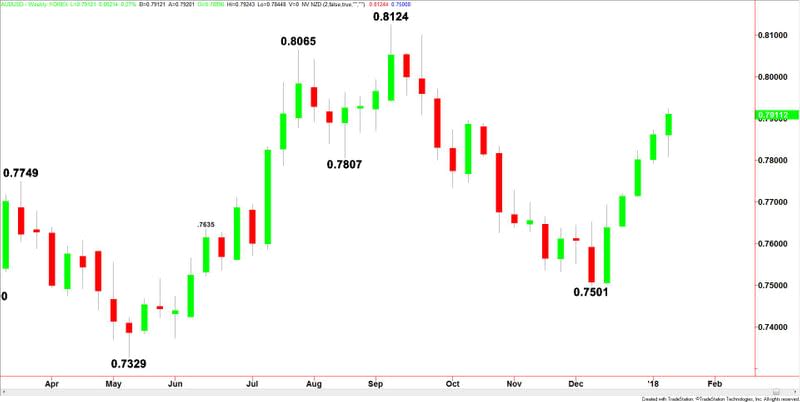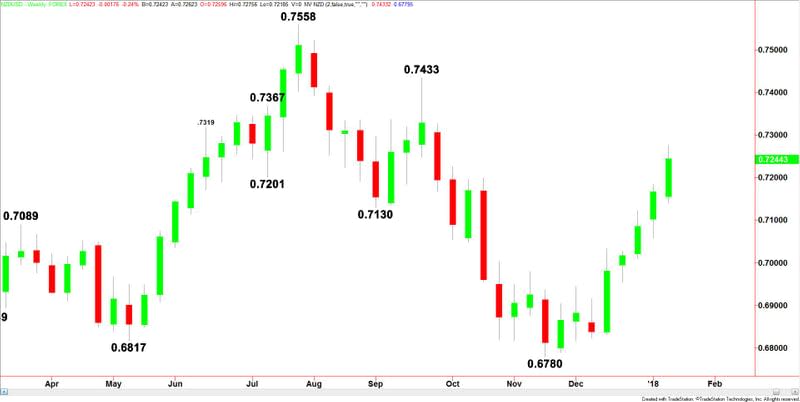AUD/USD and NZD/USD Fundamental Weekly Forecast – Driven Higher by Momentum and Optimism
The Australian Dollar was boosted last week by the steep drop in the U.S. Dollar and after stronger-than-expected November retail sales added to the view that consumer spending is picking up and fueling Aussie growth.
The AUD/USD settled at .7911, up 0.0049 or +0.62%.

Australian Retail Sales rose 1.2% last month versus a 0.4% estimate and 0.5% previous gain.
In other news, the AIG Construction Index came in lower than last month, Building Approvals rose a robust 11.7% and ANZ Job Advertisements fell 2.3%.
The New Zealand Dollar was driven by bullish technical factors as buyers continued to overcome resistance areas. Aggressive short-covering supported by an optimistic outlook for the economy, rising commodity prices and a weaker U.S. Dollar also contributed to the currency’s gains.

The NZD/USD finished the week at .7244, up 0.0077 or +1.07%.
It was a quiet week in New Zealand as far as economic data is concerned. Building Consents rose 10.8%.
The U.S. Dollar was pressured last week by a combination of factors including a major decision by the Bank of Japan, a rumor that China was going to slow down its purchases of U.S. Treasurys, weak producer prices and a soaring Euro.
Rising Treasury yields underpinned the U.S. Dollar early in the week, but that was short-lived. The dollar began to retreat from its high for the week after the Bank of Japan said it will trim its purchases of Japanese government bonds and U.S. corporate debt. The Japanese announcement raised speculation the country’s central bank may wind down its monetary stimulus this year.
The dollar declined further following a Bloomberg News report that cited unnamed sources are saying that officials in Beijing have recommended China, the largest holder of U.S. Treasurys, to slow or even halt its purchases of that debt. Later in the week, China’s foreign exchange regulator publicly refuted the Bloomberg report on Thursday, saying it cited “false information.” However, the damage was done.
The U.S. Dollar was also driven lower after U.S. producer prices fell for the first time in nearly 1-1/2 years in December amid declining costs for services.
A sharp rise in the Euro did most of the damage to the U.S. Dollar Index despite a report that showed U.S. core consumer prices posted their biggest gain in 11 months.
The dollar plunged to a more than three-year low against the Euro on Friday, as the common currency extended its gains on hopes that European Central Bank policymakers are preparing to reduce their vast monetary stimulus program.
Forecast
This week begins with a U.S. bank holiday so the AUD/USD and NZD/USD are likely to continue their rallies based on last week’s solid upside momentum.
There is only one major U.S. report this week. Building Permits are expected to come in from 1.29 million units, down from 1.30 million units.
The key reports from Australia are Thursday’s Employment Change and Unemployment Rate. The Employment Change report is expected to show the economy added 15.2K jobs in December, down from 61.6K. The Unemployment Rate is expected to come in at 5.4%, unchanged from November.
There are no major reports scheduled for New Zealand.
Hawkish Fed speakers, rising Treasury yields and upbeat U.S. economic data have not been able to stop the rallies by the Australian and New Zealand Dollars. This suggests that the strong moves will stop when major short sellers start to step up. Dovish talk from central bankers may be the catalyst behind the selling.
This article was originally posted on FX Empire

 Yahoo Finance
Yahoo Finance 